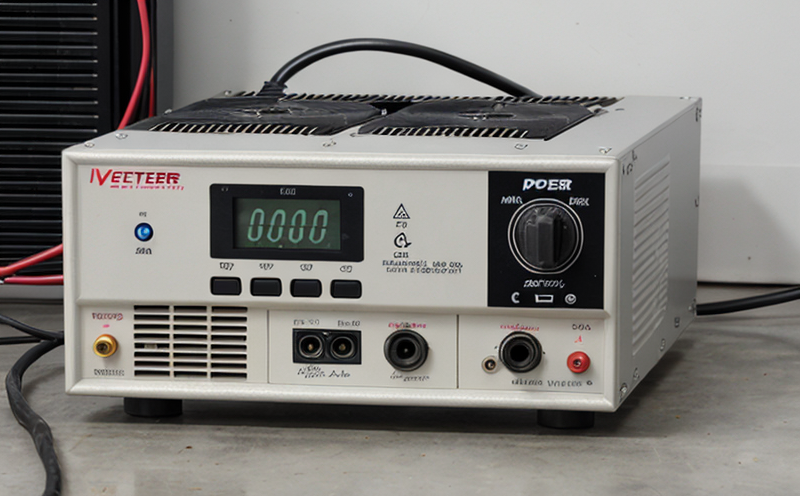IEC 61000-4-4 Electrical Fast Transient Burst Testing
The IEC 61000-4-4 standard is designed to ensure that electrical and electronic devices, particularly those in the energy sector, can withstand rapid changes in voltage. This includes transient events such as lightning strikes or switching transients, which are common occurrences in power distribution systems. Electrical fast transient (EFT) bursts can cause significant damage to sensitive components if not adequately protected. This testing ensures that inverters and other power electronics meet stringent international standards.
The IEC 61000-4 family of standards provides a framework for electromagnetic compatibility (EMC) testing, focusing on the ability of equipment to function correctly in its electromagnetic environment without causing undesirable effects. The specific burst test addresses transient voltage surges that occur over very short durations, typically between 5 μs and 2 ms.
The testing process involves applying controlled bursts of high-voltage transients to the device under test (DUT). These bursts are generated using a special waveform generator capable of producing fast rise times. The DUT is then monitored for any changes in performance or failure during these pulses. Compliance with this standard ensures that inverters and related power electronics can operate reliably even in harsh environmental conditions.
The testing procedure typically involves several steps, including setting up the equipment according to IEC 61000-4-4 specifications, preparing the DUT by connecting it to appropriate interfaces, applying the burst pulses, observing the device's response, and recording all relevant data. After completing multiple cycles of the test, the results are analyzed for compliance with the specified criteria.
Compliance with this standard is crucial for manufacturers looking to enter international markets where stringent quality control measures are enforced. It also helps in ensuring product longevity by identifying potential weaknesses early on during development and manufacturing stages.
Applied Standards:
| Standard | Description |
|---|---|
| IEC 61000-4-4:2013 | Specification for immunity to conducted electrical fast transient/burst interference. |
| IEC 61000-4-5:2010 | Specification for immunity to radiated electromagnetic disturbance. |
Use Cases and Application Examples:
| Application | Description |
|---|---|
| Solar Inverters | Ensuring safe operation during lightning strikes. |
| Wind Turbine Generators | Protecting against switching transients in power grids. |
Why Choose This Test:
- Ensures compliance with international standards.
- Identifies potential weaknesses early on.
- Enhances product reliability and durability.
- Promotes safer operation in harsh environments.
Use Cases and Application Examples:
- Solar power plants to ensure uninterrupted energy supply during adverse weather conditions.
- Wind farms to protect critical components from transient events.
Applied Standards
The IEC 61000-4 family of standards is widely recognized for its comprehensive approach to electromagnetic compatibility (EMC) testing. Specifically, the IEC 61000-4-4:2013 standard defines the requirements for electrical fast transient/burst interference immunity, which is crucial for devices operating in power systems where rapid changes in voltage can occur.
The standard specifies the test procedures and acceptance criteria for assessing the susceptibility of equipment to conducted EFT (electrical fast transient) bursts. It covers both single-pulse tests and repeated burst tests, ensuring that components are capable of withstanding these challenging conditions without failure or degradation in performance.
For compliance purposes, laboratories adhering strictly to IEC 61000-4-4 standards ensure accurate testing methods and reliable results. This standard is particularly important for manufacturers aiming at global markets where stringent quality controls are necessary.
Use Cases and Application Examples
The application of IEC 61000-4-4 EFT testing extends beyond just ensuring compliance with international standards. It plays a critical role in enhancing the reliability and durability of power electronics used in renewable energy systems.
- Solar Inverters: These devices convert direct current (DC) from photovoltaic panels into alternating current (AC), suitable for use by homes or feeding into the grid. Ensuring these inverters can withstand electrical fast transient bursts is essential to prevent outages caused by lightning strikes.
- Wind Turbine Generators: These systems generate electricity by converting wind energy into mechanical energy, then into electrical energy through generators. The harsh conditions faced by turbines, including switching transients in power grids, make EFT testing vital for maintaining operational integrity and preventing costly downtime.
The use of this test not only improves the robustness of equipment but also contributes to safer operations within renewable energy installations.





